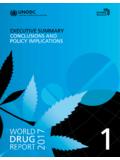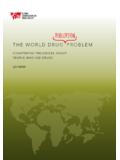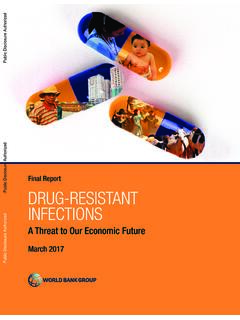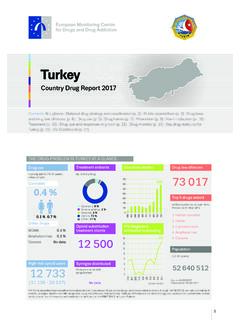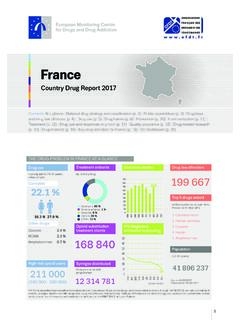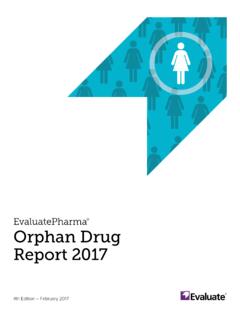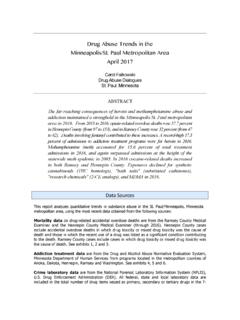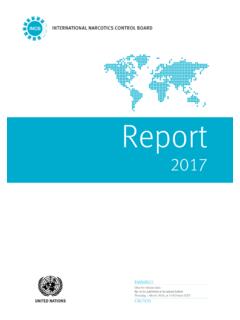Transcription of COLOMBIA - Centro de Conocimiento
1 201720172017 COLOMBIADRUG REPORTMain FindingsDrug consumption in the world According to the world drug report of the United Nations Office on Drugs and Crime-UNODC, an estimated quarter of a billion people or around 5 per cent of the global adult population aged between 15 - 64 years, used drugs at least once in 2015. Cannabis remains the world s most widely used drug , but opioids caused the highest negative health impact. Amphetamines remain the second most commonly used drug worldwide, with an estimated 35 million past-year users. It is estimated that there are nearly 17,7 million users of opiates (heroin and opium); and 17 million of past year users of cocaine worldwide and 21,6 million are estimated to be past-year users of ecstasy . drug consumption in ColombiaStudies of the Colombian drug Monitoring Centre (ODC by its acronym in Spanish) show that drug consumption is increasing in COLOMBIA , not only because there are more users, but also because the market is larger and more diverse.
2 The lifetime prevalence use increased from in 2008 to in 2013; and year prevalence increased from to during these years. Similar to other countries, in COLOMBIA cannabis is the most widely used drug , followed by cocaine, basuco and ecstasy . Although prevalence of basuco and ecstasy is low, they cause high impact on public health. As of December 2016, the ODC Early Warning System, had detected 28 new psychoactive substances (NPS) in COLOMBIA , most of which were of synthetic origin. The UNODC world drug report mentions 739 new NPS worldwide. To respond to problems related to drug use, COLOMBIA is implementing a National Policy on drug Abuse 2014-2021 that is based on four pillars: i) prevention; ii) treatment; iii) risk and harm reduction; and iv) health promotion. The main programme on drug prevention is Strengthening Families: Love and Limits , initiated in 2012 under the leadership of the Ministries of Justice and Law, and Health and Social Protection, and in close cooperation with the world Health Organization and UNODC.
3 Among the new partners to the programme, there are governorships, mayorships, and family welfare institutions reaching families, and impacting over persons, in 100 municipalities of 24 provinces in the alliance with local governments, the civil society, and the international cooperation, the national Government is gradually advancing in the set up of services for harm reduction in the country; these include a treatment with substitution with methadone, delivery of syringes, psychosocial attention, and advisory services for pre-HIV and remittance of cases, among others. On problematic drug consumption, there are in the country 384 service centres for consumers located in 25 out of the 36 health territorial entities. According to results of the Third Andean Epidemiological Study on drug Abuse among University Population in COLOMBIA , 2016, the majority of students do not use drugs; however, of the surveyed students have used them at least once in their lifetime and in the last year.
4 The same study shows that alcohol is frequently consumed, while cigarette use has decreased. Marihuana and other substances are also used, particularly LSD. According to chemical analysis, LSD is altered with at least seven different molecules, whose risks are yet unknown, as they correspond to New Psychoactive Substances. drug production in ColombiaIn COLOMBIA , the highest record of coca crops reached in 2000 with 163,000 hectares was gradualy reduced to 48,000 hectares in 2013. Thereafter, the illicit crops reached 96,000 hectares in 2015 and then 146,000 hectares in 2016. It is estimated that the potential production of cocaine base rose from 797 metric tones in 2015 to metric tones in 2016. The production of cocaine base in 2016 is equivalent to 866 metric tones of pure clorhydrate cocaine. The provinces of Nari o, Putumayo, North Santander and Cauca concentrated 72% of all the coca cropped in COLOMBIA in the last year.
5 48% ( hectares) was located in ten municipalities of four departments of the country. Tumaco was the most affected municipality, with hectares, that corresponded to 16% of all coca crops in the country. The latest trend in trafficking dynamics is to export re-oxidized cocaine to be crystalized in other countries. The information on drug seizures from COLOMBIA proves the increase of exports of cocaine base. Poppy crops reported by the Antinarcotics Police for 2016 amount to 462 hectares in the provinces of Cauca and Nari o. This amount could potentially produce metric tones of heroine. In 2016, hectares of coca crops were eradicated, and in 2017 (Jan-June) there had been hectares and informed medical and scientific use of cannabis and its derivatives in COLOMBIA .The Law 1787 of 6 July 2016 that rules the Legislative Act 02 of 2009 creates the regulatory framework that allows safe and informed medical and scientific use of cannabis and its derivatives in the Colombian national territory.
6 In 2017 , under coordinated work between the Ministry of Justice and Law, the Ministry of Health and Social Protection and the Ministry of Agriculture permitted, under Resolutions 577, 578 and 579 of 2017 , the regulation of the licensees to acquire seeds, psychoactive and non-psychoactive cannabis plants, as well as the definition of small and middle-size cannabis producers for medicinal and scientific for production of illicit drugsThe cocaine production sites show the following common typology: i) strategies for local provision of supplies and equipment; ii) support of the community to avoid interdiction by the Colombian Armed Forces; iii) increased efficiency in the productive activities; iv) fast recovery after interdiction actions by the State Armed Forces; and v) presence of foreign criminal money, that increase drug supply. Given the difficulties to eradicate illicit crops, the government devotes large efforts to locate and remove cocaine production sites that are part of the high-intermediate chain of drug production, mostly targeting the strategic links of the chain and aiming for their of narcotic drugs and chemical substances In the last years there has been an increase in the number of hectares with illicit crops.
7 This is connected to higher demand for chemical substances, and chemical products that are required to extract, refine and convert the alkaloids. The National Government has developed a series of strategies to address this problem and reduce the availability of chemical substances in the illicit market. Actions include: a) policy and control measures; b) interinstitutional work and strengthened links between the government and the enterprises; c) control measures to foreign trade activities that involve chemical substances and chemical products; and d) strengthening of control, interdiction, intelligence and joint operations of the State Armed Forces. Local markets of illicit drugsThe local markets of illicit drugs and particularly the distribution and marketing links in urban areas are major challenges for the State in terms of prioritized rational penal intervention by competent institutions in two fields: a) reduction of social vulnerability of persons and communities affected by problematic drug abuse; and b) associated criminality.
8 Evidence collected from the various exercises of the Ministry of Justice and Law poses a challenge to advance towards the formulation of policies for strengthening territorial capacities to strategically fight, the distribution and marketing of drugs by the coordinated use of tools for control, penal prosecution, and social and community intervention. It will be necesary to improve life conditions and social integration of persons, families and communities affected by the local markets of illicit drugs. Advance in the subject will allow achievements in four fields: i) networking, ii) territorial control, iii) social Intervention, iv) follow up and evaluation. Trends for adjudication of drug related offensesIn COLOMBIA , offenses related to trafficking and elaboration or carriage of narcotic drugs constitute the major cause for arrest, equivalent to 26% of the total of arrest numbers, followed by theft (16%) and physical harm (8%).
9 Nevertheless, according to surveys of the National Statistics Department (DANE by its acronym in Spanish) and the Colombian Chamber of Commerce, this is one of the top 3 most concerning offenses to the citizens. When analyzing the number of arrests by quantity and type of drug , 48% are related to coca base and basuco, while 29% correspond to marihuana. As of December 2016 there were persons imprisoned for offenses of trafficking, elaboration or carriage of narcotic drugs, of which were male ( ) and , female ( ). Out of the inmates for these offenses, correspond to convicts and to suspects. The third most common offense among inmates is trafficking and elaboration or carriage of narcotic drugs, with a participation of in the total number of offenses. Nevertheless, in cases of female detention, this is the primary offense, with a participation of In 2016 the Ministry of Justice and Law conducted a study on the judicial and health viability of implementing a model similar to the drug Courts as part of the System of Penal Responsibility for Youngsters.
10 Based on the results, and with the support of the Ministry of Health and Social Protection, the Colombian Institute of Children Welfare, the General Attorney s Office and the Bureau of International Narcotics and Law Enforcement Affairs of the US Embassy in COLOMBIA , a pilot programme was designed and is under implementation in the city of Medellin. Currently, there are 22 youngsters participating in the Programme. The Ministry of Justice and Law has received requests from four other provinces to replicate the Programme. drug consumption in the world According to the world drug report of the United Nations Office on Drugs and Crime-UNODC, an estimated quarter of a billion people or around 5 per cent of the global adult population aged between 15 - 64 years, used drugs at least once in 2015. Cannabis remains the world s most widely used drug , but opioids caused the highest negative health impact.

